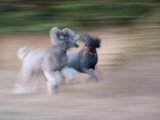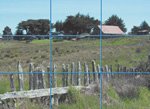Tips for Better Digital Photography
| Get Up Close Too many photographers shy away from their subjects. Get close to show detail. If you can't get physically closer, use your camera's zoom feature, if it has one. If your camera has a macro feature, use it to take extreme close-ups of flowers, rocks, seashells, tattoosyou name it. Don't limit yourself to wide shots. Vary Your Angle Don't just shoot from a standing position. Get down into a crouch and shoot low or get up on a chair and shoot down. Vary your angles. The LCD screen on a digital camera makes it easyyou don't press your eye to the camera to compose a shot. Changing your angle can be a great way to remove a cluttered background. When photographing flowers, for example, I like to position the camera low and aim it upwards, so that the flower is shot against the sky. Avoid Digital Zooming Many digital cameras supplement their optical zoom lenses with digital zoom functions that bring your subject even closer. Think twice about using digital zoomit usually adds undesirable artifacts to an image. Position the Horizon In landscape shots, the position of the horizon influences the mood of the photo. To imply a vast, wide open space, put the horizon along the lower third of the frame and show lots of sky. (This obviously works best when the sky is cooperating.) To imply a sense of closeness or if the sky is a bland shade of gray put the horizon along the upper third, showing little sky. This rule, like others, is meant to be broken. For example, if you're shooting a forlorn-looking desert landscape, you might want to have the horizon bisect the image to imply a sense of bleak monotony. Crop Carefully You can often use iPhoto's cropping tool to fix composition problems. But note that cropping results in lost pixels, and that may affect your ability to produce high-quality prints. Try to do your cropping in the camera's viewfinder, not iPhoto. Kill Your Flash I turn off my camera's built-in flash and rarely turn it on. Existing light provides a much more flattering, natural-looking image, with none of the harshness of electronic flash. Dimly lit indoor shots may have a slight blur to them, but I'll take blur over the radioactive look of flash any day. Beware of the Background More accurately, be aware of the background. Is a tree growing out of Mary's head? If so, move yourself or Mary. Are there distracting details in the background? Find a simpler setting or get up close. Is your shadow visible in the shot? Change your position. When looking at a scene, our brains tend to ignore irrelevant things. But the camera sees all. As you compose, look at the entire frame, not just your subject. Embrace Blur A blurred photo is a ruined photo, right? Not necessarily. Blur conveys motion, something still images don't usually do. A photo with a sharp background but a car that is blurred tells you the car was in motion. To take this kind of shot, keep the camera steady and snap the shutter at the moment the car crosses the frame. You can also convey motion by turning this formula around: If you pan along with the moving car as you snap, the car will be sharp but the background will be blurred. Here's a canine-oriented example. Compose Carefully Following a couple of rules of thumb can help you compose photos that are more visually pleasing. First, there's the age-old rule of thirds, in which you divide the image rectangle into thirds and place your photo's subject at or near one of the intersections of the resulting grid. Place your photo's subject at or near these intersections. This composition technique yields images that are more visually dynamic. A second technique is to draw the viewer's eyes to your subject and add a sense of dynamism by using diagonal lines, such as a receding fence. No Tripod? If you want to take sharp photos in low light, mount your camera on a tripod. If you don't have a tripod handy, here's a workaround: turn on your camera's self-timer modethe mode you'd usually use when you want to get yourself in the picturethen set the camera on a rigid surface and press the shutter button. Because you won't be holding the camera when the shutter goes off, you won't risk getting a blurred shot. |
- Linking the IT Balanced Scorecard to the Business Objectives at a Major Canadian Financial Group
- Measuring ROI in E-Commerce Applications: Analysis to Action
- Technical Issues Related to IT Governance Tactics: Product Metrics, Measurements and Process Control
- The Evolution of IT Governance at NB Power
- Governance Structures for IT in the Health Care Industry






